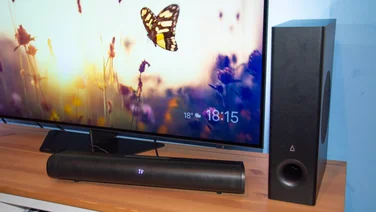To help us provide you with free impartial advice, we may earn a commission if you buy through links on our site. Learn more



Blue Microphones’ move from the studio to high-end consumer recording environments has been a great success over the last couple of years. The company’s high quality condenser microphones are great for recording podcasts or live performances of acoustic music.
While dynamic microphones use an electric coil connected to a diaphragm to convert sound waves into an electrical signal, condenser microphones have a diaphragm that acts as one of a plate of a capacitor. Constant voltage, in this case supplied via the USB connection, is applied to the circuit, which includes the diaphragm and a second fixed plate. As sound waves cause the diaphragm to vibrate, the capacitance between the plates changes. This alters the voltage across the capacitor, generating the changing electrical signal which communicates the sound to your recording or output medium. Condenser microphones typically have a wide, accurate frequency response and great sensitivity to relatively quiet sounds. However, they also require external power. In this case, that power is provided by your PC or iPad.

Unlike most of Blue’s previous USB microphones, the Blue Microphones Spark Digital 803 can connect to an iPad or iPhone as well as a PC. However, there’s no XLR output, which means you can’t send analogue audio to a mixing desk or audio production sound card. It comes with two cables that can be connected to a micro USB port at the bottom of the microphone. One cable has a standard USB port and the other has a 30-pin connecter for older iOS devices. Both cables split into a Y-shape, and have a female 3.5mm headphone connector that you can use to monitor or listen back to your recordings. Worryingly, the plastic case around the 30-pin connector started to split apart when we connected it to the iPad, although it did work perfectly after we’d squeezed it back together.
If you have a more recent iPad or iPhone that uses a Lightning connector, you’ll have to use a 30-pin to Lightning adaptor, which you can get for around £12. The company is looking into the option of providing a Lightning connector in the future, but one isn’t available at the time of writing. The Spark Digital 830 comes with a silver stand comprised of a heavy metal base and a plastic cradle into which you can screw the microphone. Part of the support is made of thick elastic that surrounds the screw mount. It looks weird, but it provides protection against vibrations that would otherwise be conducted to the microphone and affect your recording.

Also included is the Blue Microphones Cloud Production bundle, which gives you six-month accounts for music distribution platform Soundcloud Pro and the Gobbler online audio sharing website. Although these are glorified demos, both are useful enough to be worth using if you don’t already have something in place to store and publish your audio work.
The Spark Digital 830’s audio quality is simply fantastic, particularly when it comes to recording vocals. Some other USB condenser microphones from Blue have multiple settings, but the Spark Digital 830 just has a combined gain and headphone volume dial that also serves as a mute button, and a focus switch on the other side of the microphone.
Blue claims that with the focus switch off, the mic will have great low frequency sensitivity, while turning it on provides greater clarity and detail in mid-range and higher frequencies. We initially found that switching on the focus switch meant that the mic was more prone to picking up the background hum of a noisy laptop that we’d left on the table in front of it. However, once we moved interference sources out of the mic’s recording area, we found that enabling focus added body and detail to an alto singing voice, but resulted in slightly less full recordings of speech.

We found it harder to get good quality recordings when using the Spark Digital 830 with our iPad, as its recording volume was much weaker than when we used it with a PC. Increasing the gain to compensate for this meant that occasional distortions were introduced to the recording during louder parts of our performance. The results, recorded using GarageBand, were impressive and would be fine for rough demos, but they lacked the professional polish of our PC-based efforts.
The Spark Digital 830 is a great condenser microphone for recording vocals, podcasts, interviews or even full acoustic demos. However, it’s very much a niche product. If you do a lot of recording on the road and use an iPad as your main computer while doing so, then it’s great – assuming you either have an older iPad or the relevant converter. However, most keen audio producers will be better off with Blue Microphones Yeti Pro, which is similarly priced, has more configuration options and an XLR output rather than iPad support, making it much more useful in the studio and home.
| Details | |
|---|---|
| Price | £160 |





